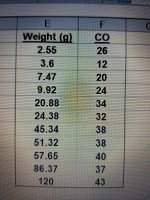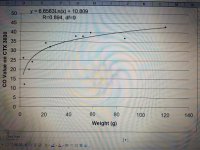LawrencetheMDer
Hero Member
- Feb 22, 2014
- 986
- 2,406
- 🏆 Honorable Mentions:
- 2
- Detector(s) used
- Minelab Manticore, Minelab CTX3030 w 11" and 17" DD coils,
Minelab Excalibur II w 10" coil, Equinox 800 (4) w 11" and 15" coils,
Troy Shadow x2 w 7" coil, Pointers; Garrett Carrot, Pro Find 35,
- Primary Interest:
- Beach & Shallow Water Hunting
I've had my CTX 3030 for about a year now and couldn't be happier. With 17" coil and ability to define my area of acceptance, I can cover a lot of beach and not be plagued by to much junk. I can decide whether to dig most coins since their values are fairly stable and I sometimes concentrate on the gold numbers of 12:02, 12:09-12:14, and 12:24-12:36. However, one plague is aluminum foil and another is lead fishing weights.
Both aluminum and lead have the ability to appear just about anywhere along the CO axis; although ALL CTX users would recognize the FE:CO coordinates of 12:15 to 12:23 as push-tab and pull-tab areas. I have had aluminum of various types, usually foil, show-up anywhere from 12:01 to 12:42 along the FE:CO coordinates, with the FE axis more or less stable at 12 with different aluminum and lead objects. Lead fishing weights also span a large range of CO numbers from 12 to 43 as demonstrated in the present blog.
As noted in the CTX 3030 Handbook by Andy Sabisch, the CO (and FE) scale is arbitrarily named and doesn't relate to conductivity as the abbreviation might suggest. As Andy notes on page 15, the CO axis could have easily been named the X-axis and the CTX is not doing some type of metallurgical analysis.
One impression after using the CTX 3030 for a year is that the CO scale from 1 to 50 relates to size and/or weight of an object. For example, it is the smallest pieces of aluminum that ring in at 12:01 and a Can top can ring in at 12:32 or so. To test this impression of CO number and objects weight, I took 11 fishing weights of varying weight (and size), from 12 to 120 grams, and recorded FE:CO coordinates for each with an air test at constant distance from the coil (1").
Table 1 shows the weights and CO numbers, correspondingly. [Ideally the fishing weights should be the same shape, but ya can't have everything.] The FE scale or number was fairly constant at 12, although the smallest weight registered 9, the second smallest registered 14 and the 8th heaviest had an FE of 11. All others had an FE of 12.

The graph shows lead weight in grams (x-axis) against CO number on the CTX 3030 (y-axis). The solid line represents a regression line (log scale) and the R value shows the correlation between CO number and weight. A correlation of 0.894 (with df=9) suggests a very strong relationship between the two measures. In other words, most of the change along the CO axis can be considered a measure of weight, to the first approximation. Lighter objects correspond to low CO numbers and heavier objects correspond to higher CO numbers.

Because size and weight change at the same time (as an object gets heavier it also gets larger), it is not possible to tease apart whether CO number varies more with one or the other. Suffice it to say, however, that an object's weight/size corresponds closely to CTX 3030 CO number. Thus, gold bands can very anywhere along the CO axis. Personally, last year I found a small band (1.22g) at 12:02, after digging 100 foil juice tops, and this year found a larger gold band (10 grams) at 12:14.
If aluminum and lead very along the CO axis based on weight/size, than the forced conclusion is that gold can appear anywhere along the CO axis including in the aluminum range of 12:15-23 and could even occur at cent coordinates of 12:37 and 12:40. Indeed, I'm kept up at night thinking about the report of a hunker of a gold ring appearing at 12:37 - a coordinate reserved for a cent. Perhaps it is best to dig all targets, regardless of CO number...ya just never know.
Both aluminum and lead have the ability to appear just about anywhere along the CO axis; although ALL CTX users would recognize the FE:CO coordinates of 12:15 to 12:23 as push-tab and pull-tab areas. I have had aluminum of various types, usually foil, show-up anywhere from 12:01 to 12:42 along the FE:CO coordinates, with the FE axis more or less stable at 12 with different aluminum and lead objects. Lead fishing weights also span a large range of CO numbers from 12 to 43 as demonstrated in the present blog.
As noted in the CTX 3030 Handbook by Andy Sabisch, the CO (and FE) scale is arbitrarily named and doesn't relate to conductivity as the abbreviation might suggest. As Andy notes on page 15, the CO axis could have easily been named the X-axis and the CTX is not doing some type of metallurgical analysis.
One impression after using the CTX 3030 for a year is that the CO scale from 1 to 50 relates to size and/or weight of an object. For example, it is the smallest pieces of aluminum that ring in at 12:01 and a Can top can ring in at 12:32 or so. To test this impression of CO number and objects weight, I took 11 fishing weights of varying weight (and size), from 12 to 120 grams, and recorded FE:CO coordinates for each with an air test at constant distance from the coil (1").
Table 1 shows the weights and CO numbers, correspondingly. [Ideally the fishing weights should be the same shape, but ya can't have everything.] The FE scale or number was fairly constant at 12, although the smallest weight registered 9, the second smallest registered 14 and the 8th heaviest had an FE of 11. All others had an FE of 12.

The graph shows lead weight in grams (x-axis) against CO number on the CTX 3030 (y-axis). The solid line represents a regression line (log scale) and the R value shows the correlation between CO number and weight. A correlation of 0.894 (with df=9) suggests a very strong relationship between the two measures. In other words, most of the change along the CO axis can be considered a measure of weight, to the first approximation. Lighter objects correspond to low CO numbers and heavier objects correspond to higher CO numbers.

Because size and weight change at the same time (as an object gets heavier it also gets larger), it is not possible to tease apart whether CO number varies more with one or the other. Suffice it to say, however, that an object's weight/size corresponds closely to CTX 3030 CO number. Thus, gold bands can very anywhere along the CO axis. Personally, last year I found a small band (1.22g) at 12:02, after digging 100 foil juice tops, and this year found a larger gold band (10 grams) at 12:14.
If aluminum and lead very along the CO axis based on weight/size, than the forced conclusion is that gold can appear anywhere along the CO axis including in the aluminum range of 12:15-23 and could even occur at cent coordinates of 12:37 and 12:40. Indeed, I'm kept up at night thinking about the report of a hunker of a gold ring appearing at 12:37 - a coordinate reserved for a cent. Perhaps it is best to dig all targets, regardless of CO number...ya just never know.
Amazon Forum Fav 👍
Upvote
0



